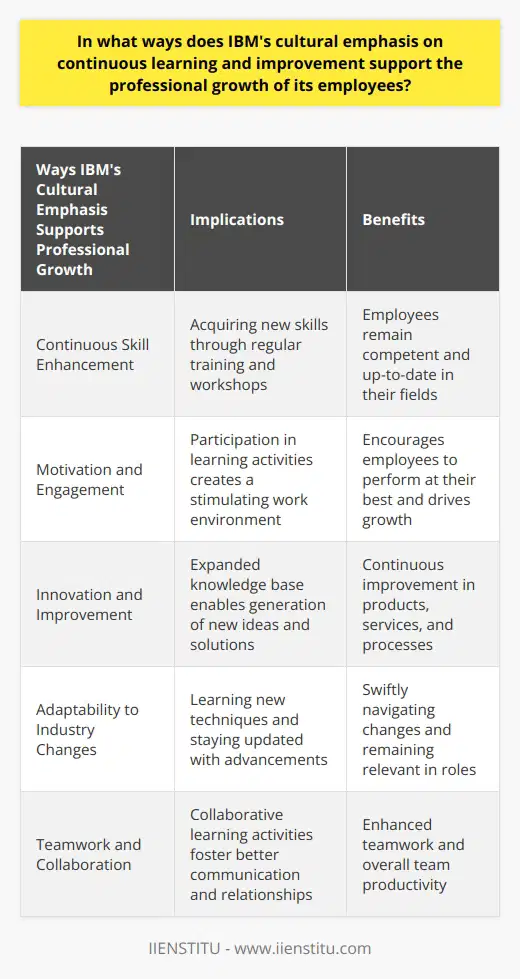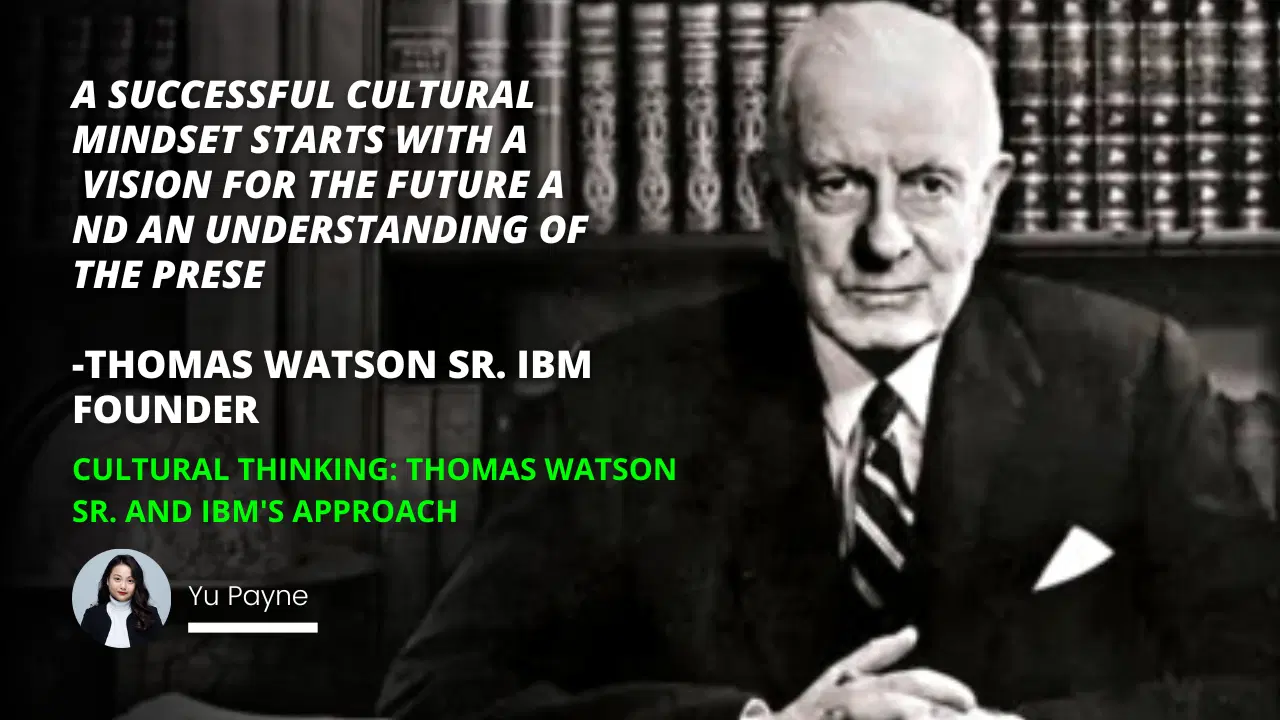
As I sat in a bustling café one afternoon, sipping my coffee and watching people hurry by, it struck me how diverse our world truly is. Each person carries a unique set of beliefs, values, and cultural backgrounds that shape their worldview. This realization reminded me of how crucial cultural thinking is, not just in our personal lives but significantly in the business world as well. Understanding and appreciating this diversity can transform organizations from ordinary entities into extraordinary communities.
History of Cultural Thinking
Cultural Thinking and Business Practices
The Power of Cultural Thinking
Embracing the Roots of Cultural Thinking
Growing up, I often heard stories about pioneers who changed the face of industries. One name that frequently came up was Thomas Watson Sr., the legendary founder of IBM. But it wasn't just his business acumen that left a mark; it was his profound understanding of cultural thinking in business practices that truly set him apart.
Back in the early 20th century, businesses were predominantly focused on profits, often at the expense of ethical considerations and societal impact. Companies would engage in cut-throat tactics, disregarding the long-term consequences of their actions on communities and the environment. This approach led to a widespread sense of distrust and tension between corporations and the public. I recall reading about communities that suffered because a company's short-term gain didn't consider their long-term wellness.
Then came Watson Sr., who envisioned a different kind of enterprise. He spoke of a "spirit of mutual confidence and service." Instead of solely chasing profits, he emphasized ethical practices and a consciousness of societal benefits. This was revolutionary! Imagine leading a company where integrity, respect, and individual appreciation weren't just buzzwords but the very foundation of the corporate culture.
The Journey of Cultural Thinking in Business
One might wonder, how does cultural thinking manifest in daily business operations? Well, it's woven into the very fabric of how decisions are made and how people are treated. For instance, when companies:
Encourage open communication, they foster an environment where employees feel valued and heard.
Recognize and reward ethical behavior, they set a standard that integrity matters more than short-term gains.
Promote diversity and inclusion, they benefit from a wide range of perspectives and ideas.
I remember working at a company that truly embraced these principles. Every decision, from hiring to product development, was made with an eye on both business success and societal impact. We often collaborated with local communities, ensuring our projects aligned with their needs and values. This approach didn't just make us feel good; it translated into customer loyalty and long-term partnerships.
Cultural thinking encourages us to reflect rather than simply compete. It's not about being the best at any cost but about understanding the broader implications of our actions. This mindset helps employees and customers alike to grasp the company's mission and see where they fit within it. When everyone is aligned, the organization moves forward cohesively.
The Power Unleashed by Cultural Thinking
There's a particular power that comes from embedding cultural thinking into an organization. Watson Sr. believed in mobilizing the will of the employee, inspiring each person to become the best version of themselves. When individuals feel appreciated not just for their work but for who they are, their potential is limitless. I've seen colleagues go above and beyond because they felt genuinely valued.
A thriving cultural mindset starts with a vision for the future and an understanding of the present.
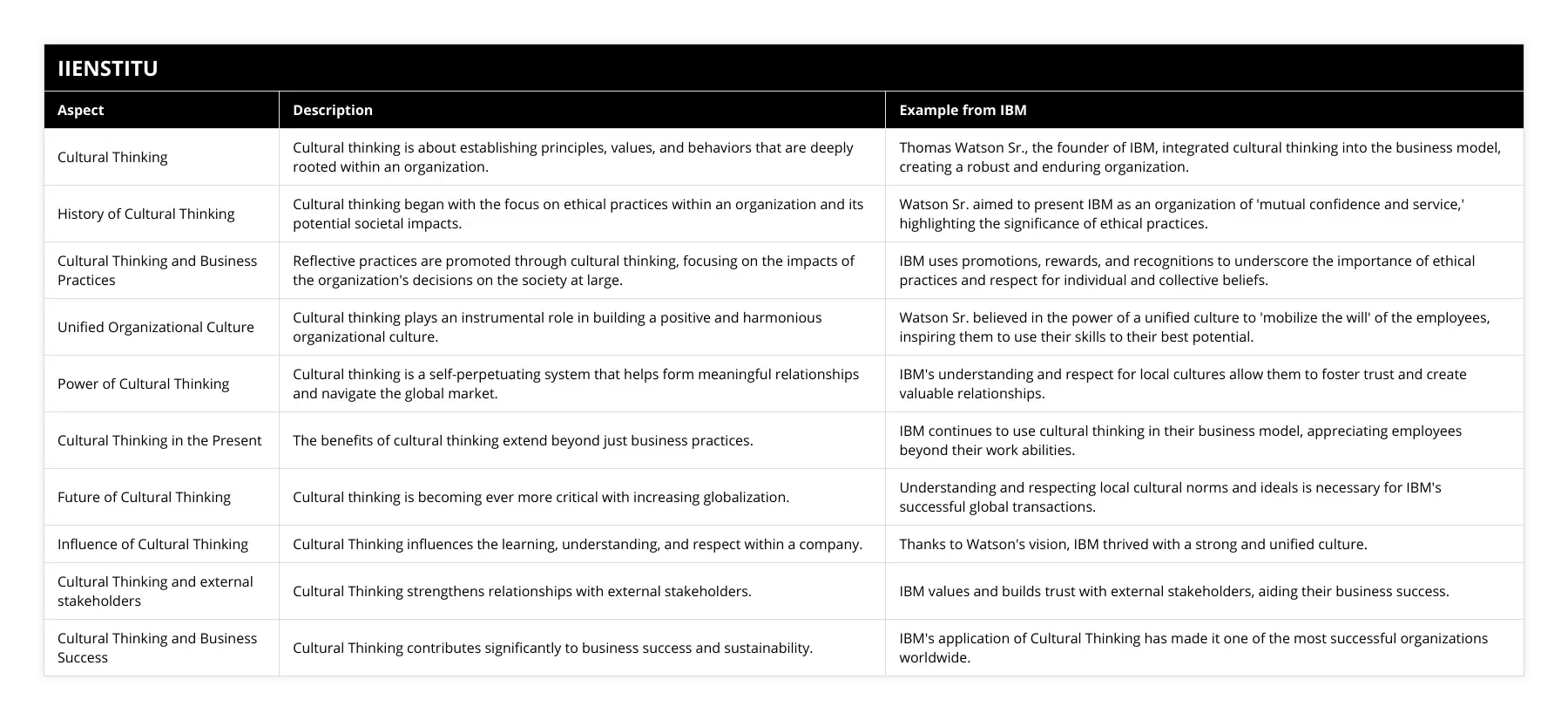
Here are some ways cultural thinking empowers businesses:
1- Strengthens Internal Culture: A unified culture promotes teamwork and reduces conflicts. When everyone shares common values, collaboration becomes seamless.
2- Enhances Reputation: Companies known for strong ethical values attract customers and partners who share those values.
3- Facilitates Global Expansion: Understanding and respecting cultural norms is essential when entering new markets. It's not just about translating languages but about connecting on a deeper level.
4- Drives Innovation: Diverse perspectives lead to innovative solutions. When employees from different backgrounds come together, they bring unique ideas to the table.
5- Builds Resilience: Companies grounded in strong cultural principles are better equipped to navigate challenges and adapt to changes.
Navigating the Global Market with Cultural Insights
In today's world, globalization isn't just a concept; it's our reality. Businesses are expanding across borders, interacting with cultures vastly different from their own. Here, cultural thinking becomes not just beneficial but necessary. Understanding local customs, values, and social climates can make or break business deals.
I recall a friend's experience working for a company that was expanding into Asia. Initially, their approach was very Western-centric, and they faced numerous setbacks. It wasn't until they took the time to understand and respect the local culture that they began to see success. They started incorporating local traditions into their business practices, celebrating regional holidays, and even adjusting their management styles to better suit their new team members. This not only improved their business outcomes but also built trust and strong relationships with local stakeholders.
Personal Reflections on Cultural Thinking
On a personal note, embracing cultural thinking has enriched my professional journey. It has taught me the importance of empathy and open-mindedness. In one of my previous roles, I was tasked with leading a team spread across different continents. At first, the cultural differences seemed like hurdles. But as I invested time in understanding each team member's background, we found common ground and learned from each other.
This experience highlighted that:
Effective communication goes beyond words; it requires understanding context and non-verbal cues.
Building relationships is crucial. Taking the time to get to know colleagues personally can enhance collaboration.
Adaptability is key. Being willing to adjust our own behaviors can foster a more inclusive environment.
Applying Cultural Thinking Beyond Business
Interestingly, the principles of cultural thinking aren't confined to large corporations. They can be applied in various aspects of life, including when we're seeking changes in our own careers. For instance, when writing a reassignment request letter, tips and information rooted in cultural understanding can make a significant difference. By acknowledging the values and expectations of the organization, and aligning our requests accordingly, we're more likely to achieve favorable outcomes.
Steps to Cultivate Cultural Thinking in Your Organization
If you're inspired to bring cultural thinking into your workplace, here are some practical steps:
1- Develop a Clear Vision and Values Statement: This sets the foundation for your organization's culture.
2- Foster Open Dialogue: Create platforms where employees can share ideas and express concerns.
3- Invest in Cultural Competency Training: Equip your team with the skills to navigate diverse environments.
4- Lead by Example: Management should embody the cultural values they wish to see.
5- Recognize and Celebrate Diversity: Acknowledge different cultures, traditions, and perspectives within your team.
The Ongoing Impact of Watson Sr.'s Vision
Reflecting on Thomas Watson Sr.'s legacy, it's evident that his innovative approach didn't just benefit IBM but set a precedent for businesses worldwide. His emphasis on cultural thinking has proven timeless, guiding organizations through decades of change. By prioritizing a strong and unified culture, companies can thrive sustainably, build lasting relationships, and make meaningful contributions to society.
Conclusion
A thriving cultural mindset indeed starts with a vision for the future and a keen understanding of the present. As we've journeyed through the history and impact of cultural thinking, it's clear that this approach holds immense power. Whether it's inspiring employees to reach their full potential, navigating global markets, or simply fostering a more inclusive workplace, cultural thinking is a cornerstone of modern business success.
In embracing these principles, we not only honor the trailblazers like Watson Sr. but also pave the way for future generations to lead with integrity and respect. So, let's commit to cultivating cultural thinking in our organizations and watch as it transforms not just our businesses but the world around us.
References
Watson, T. J. Sr. (1990). Father, Son & Co.: My Life at IBM and Beyond. Bantam Books.
Collins, J. (2001). Good to Great: Why Some Companies Make the Leap... and Others Don't. HarperCollins.
Schein, E. H. (2010). Organizational Culture and Leadership. Jossey-Bass.
Deal, T. E., & Kennedy, A. A. (2000). Corporate Cultures: The Rites and Rituals of Corporate Life. Perseus Books.
Hofstede, G. (1991). Cultures and Organizations: Software of the Mind. McGraw-Hill.
Remember, the journey of a thousand miles begins with a single step. Let's take that step towards embracing cultural thinking today!
Frequently Asked Questions
What is Cultural Thinking, and how does it benefit an organization?
Cultural Thinking is a deep-rooted aspect of a company that establishes the principles, values, and behaviors to be upheld within an organization. This approach emphasizes ethical practices, social responsibility, and respect for individual and collective beliefs, essential in building a positive corporate culture. Cultural Thinking promotes reflective practices over competitive ones by encouraging companies to consider how their decisions affect society's well-being. Through promotions, rewards, or recognition measures, companies can emphasize the importance of various ethical concerns, models of integrity, and respect for individual and collective beliefs.
Cultural Thinking helps employees and customers better understand the company's goals and mission and where they fit in fulfilling these. A strong and unified culture inspires employees to become the best possible versions of themselves and use their talents to the fullest extent. Appreciating employees beyond their work abilities and recognizing the person they are individuals helps create a favorable and unified culture within the organization.
Cultural Thinking is particularly effective in creating a positive, unified organizational culture. Watson Sr. believed that the power of a strong and unified culture could "mobilize the will" of employees, inspiring them to use their talents to the fullest extent. This builds a steady foundation for the organization and aids the formation of meaningful relationships within and outside the enterprise. Cultural Thinking becomes a self-perpetuating system that continuously strengthens relationships with external stakeholders, fostering trust and unity.
Cultural Thinking is essential in navigating an increasingly global market. By understanding and respecting a culture's norms and ideals, companies gain access to valuable opportunities that foster trust and relationships, allowing them to thrive. In addition, understanding the local social climate is necessary for successful transactions in an age of near-constant globalization. Companies that embrace Cultural Thinking can create a space for learning, understanding, and respect, which fosters solid and unified cultures within the enterprise and strengthens relationships with external stakeholders. This, in turn, helps companies thrive in an increasingly globalized business environment.
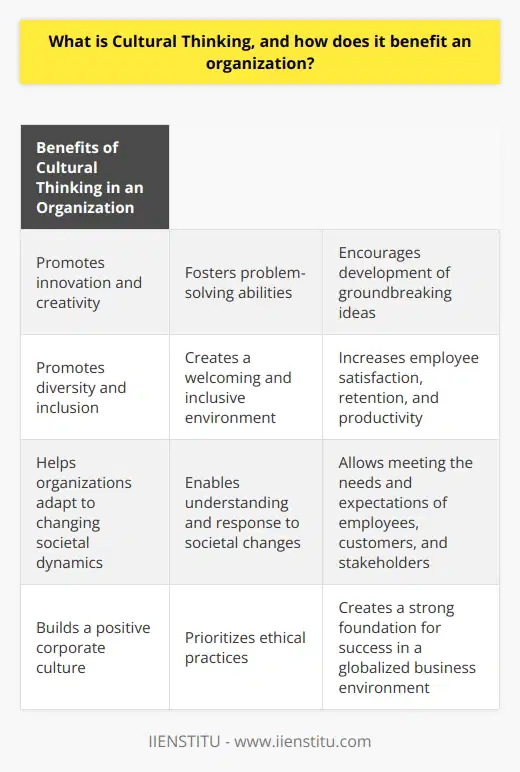
What role did Thomas Watson Sr. play in incorporating Cultural Thinking into modern business practices?
Thomas Watson Sr. was a visionary leader who understood the importance of creating a solid organizational culture prioritizing ethical practices, the consciousness of societal benefit, and respect for individual and collective beliefs. He believed that businesses had a responsibility to serve the community and society at large and that they should operate in a way that reflects this responsibility.
Watson Sr.'s vision for IBM was a "spirit of mutual confidence and service," emphasizing the importance of creating a solid organizational culture based on trust, respect, and collaboration. He believed this culture would mobilize the employee's will, inspiring them to become the best possible version of themselves and use their talents to the fullest extent.
Watson Sr.'s emphasis on Cultural Thinking marked a radical departure from the conventional business models of the time. Many businesses focused solely on short-term success through cut-throat tactics, disregarding any consequential impacts on society. This led to a sense of underlying tension and distrust in the corporate space, and corporations played a limited role in the public good.
Watson Sr.'s approach was different. He believed that businesses were responsible for operating in a way that benefits society. By prioritizing ethical practices, the consciousness of societal benefit, and respect for individual and collective beliefs, he believed that IBM could create a solid organizational culture that would inspire employees and benefit society.
Watson Sr.'s approach to Cultural Thinking proved to be highly effective. As a result, IBM became one of the most successful organizations in the world, with a reputation for ethical practices and a commitment to serving the community. His emphasis on creating a solid organizational culture based on trust, respect, and collaboration has become critical to modern business practices worldwide.
In conclusion, Thomas Watson Sr. was a visionary leader who pioneered Cultural Thinking into the business model. His emphasis on ethical practices, the consciousness of societal benefit, and respect for individual and collective beliefs marked the beginnings of Cultural Thinking, which has become a critical part of modern business practices worldwide. His legacy inspires business leaders to prioritize social responsibility and create solid organizational cultures that benefit employees and society.
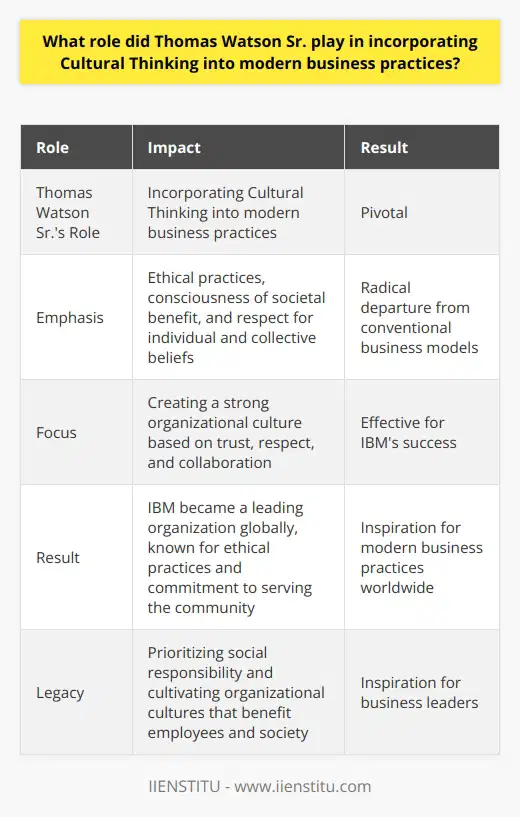
How does Cultural Thinking help companies navigate an increasingly global market?
As the world becomes increasingly interconnected, businesses must adapt to a global market that demands cultural sensitivity and awareness. Artistic Thinking is a critical tool for companies looking to thrive in this environment. Understanding and respecting a culture's norms and ideals is necessary for successful transactions in an age of near-constant globalization.
Cultural Thinking involves taking a step back from a company's traditional approach and considering how decisions affect society's well-being. This approach prioritizes ethical practices and consciousness of societal benefit over cut-throat tactics that may have short-term success but disregard any consequential impacts on society. By embracing Cultural Thinking, companies can establish a deep-rooted aspect of their identity that strives to be continuously cultivated. This is particularly effective in creating a positive, unified organizational culture.
Cultural Thinking allows companies to develop meaningful relationships within and outside the organization. Companies gain access to valuable opportunities that foster trust and relationships by understanding the local social climate. In addition, when companies take the time to learn about the culture of the communities they serve, they can better understand the needs of their customers and tailor their approach to meet those needs. This, in turn, leads to greater customer satisfaction and loyalty.
Cultural Thinking also strengthens relationships with external stakeholders. By embracing the principles of Cultural Thinking, companies can establish trust with other businesses, organizations, and communities. This trust allows companies to develop partnerships that lead to new opportunities and growth. These relationships can be precious in emerging markets where trust and respect are essential for building successful business ventures.
In conclusion, Cultural Thinking is essential for companies navigating an increasingly global market. Companies can gain access to valuable opportunities that foster trust and relationships by understanding and respecting a culture's norms and ideals. This helps companies establish a solid and unified organizational culture and strengthen relationships with external stakeholders, allowing them to thrive in an increasingly globalized business environment.
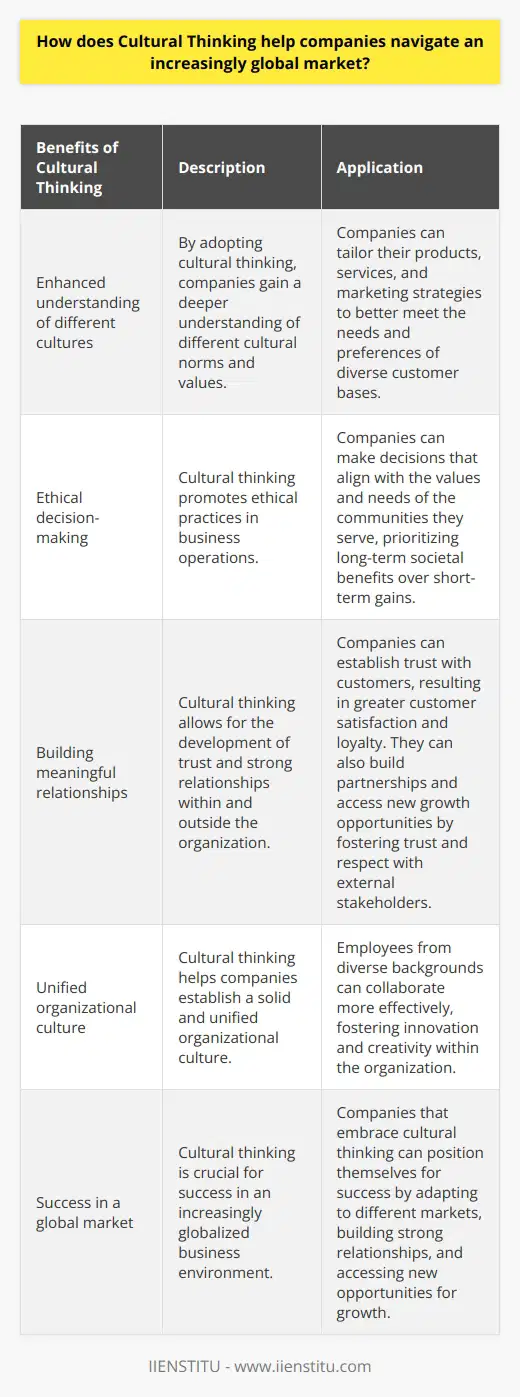
What is IBM's culture formula and how does it impact the organization?
IBM's Culture Formula
IBM's culture formula can be understood as a combination of three main pillars: innovation, collaboration, and client-centricity. This unique blend of factors creates an environment that fosters growth, creativity, and optimal performance within the organization.
Innovation
A foundational element of IBM's culture formula is the emphasis on innovation. By fostering an atmosphere that encourages employees to think creatively and challenge the status quo, IBM is able to stay at the forefront of technological advancements. This commitment to innovation not only impacts the products and services that IBM develops, but also empowers its workforce to continuously push the boundaries of their own personal and professional development.
Collaboration
Another vital component of IBM's culture formula is the focus on collaboration. By promoting open communication, cross-functional teamwork, and diverse perspectives, IBM ensures that its employees are able to leverage their collective knowledge and skills to develop the most effective solutions. This emphasis on collaboration creates a more cohesive organization and enables employees to develop stronger relationships with their peers.
Client-Centricity
Lastly, client-centricity is a core tenet of IBM's culture formula. By prioritizing the needs and expectations of their clients, IBM is better able to develop and implement solutions that are tailored to meet each client's unique objectives. This customer-focused orientation not only drives business success but also enhances the professional satisfaction of employees as they are able to see the direct impact of their work on client outcomes.
Impact on the Organization
IBM's culture formula has significant implications for the organization as a whole. The focus on innovation encourages a culture of continuous learning and improvement, resulting in cutting-edge products, services, and solutions. Collaboration within the organization bolsters teamwork and synergy between departments, helping the company to function more efficiently and effectively. Finally, by making client-centricity a core value, IBM demonstrates its commitment to customer satisfaction and long-term relationships, ultimately leading to sustained growth and success.
In conclusion, IBM's culture formula, comprised of innovation, collaboration, and client-centricity, creates an environment that fosters employee engagement and personal development while simultaneously driving organizational success. By nurturing a culture that values these three pillars, IBM is able to outpace competitors and maintain its position as a leader in the technology industry.
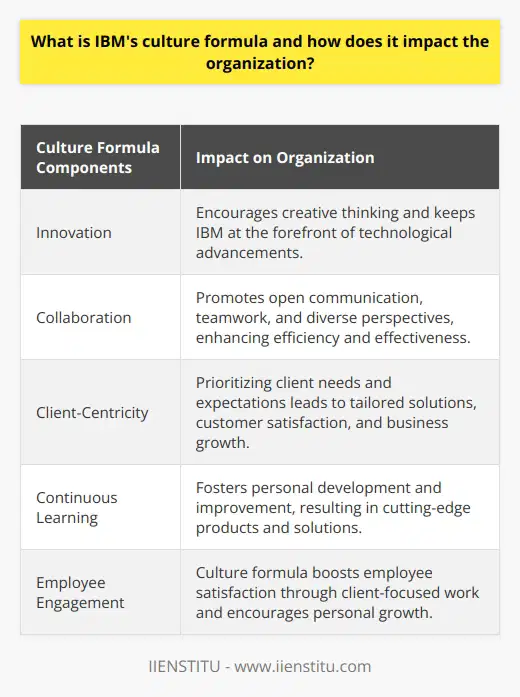
How do IBM's three basic beliefs shape its corporate culture and influence employee behavior?
Basic Belief 1: Importance of Respect
IBM's first basic belief, according respect to every individual, greatly contributes to its corporate culture by fostering a supportive and inclusive environment. In this atmosphere, employees feel valued and respected, stimulating a sense of belonging and commitment. This respect-based approach promotes better communication and collaboration, as individuals feel comfortable expressing their ideas and opinions openly, knowing they will be treated with dignity. Moreover, this inclusive culture encourages diverse perspectives, elevating IBM's creativity and innovation.
Basic Belief 2: Pursuit of Excellence
The second basic belief of IBM, the pursuit of excellence, is manifested through the company's focus on continuous improvement and dedication to delivering high-quality products and services. This belief inspires employees to strive for excellence in their professional and personal lives, cultivating a work ethic that emphasizes efficiency, productivity, and innovation. The commitment to excellence encourages employees to develop their skills and knowledge, resulting in a highly skilled workforce capable of solving complex problems and meeting clients' demands. Additionally, it promotes accountability and responsibility, helping to maintain a high standard of performance across the organization.
Basic Belief 3: Long-Term View
The third basic belief, taking a long-term view, encourages IBM employees to prioritize sustainable growth and lasting success over short-term gains. By adopting a future-oriented approach to decision-making, employees consider the long-term repercussions of their actions, resulting in more strategic and informed choices. This perspective not only contributes to stable organizational growth but also fosters a sense of commitment and loyalty among employees who share the company's long-term vision. This long-term focus minimizes impulsive decision-making and promotes patience, planning, and persistence, crucial traits for navigating the ever-changing business landscape.
In conclusion, IBM's three basic beliefs - respect for the individual, the pursuit of excellence, and a long-term focus - are critical factors that shape its corporate culture and influence employee behavior. These beliefs create an inclusive, performance-driven environment that supports personal and professional growth, ultimately contributing to the sustainable success of the company. By promoting a mutual understanding and adherence to these values, IBM fosters a culture defined by innovation, collaboration, and resilience.
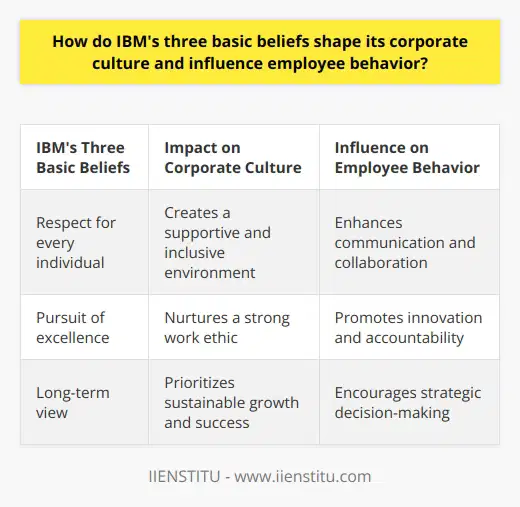
Can you identify a cultural symbol associated with IBM and explain its significance in representing the company's values?
Cultural Symbol of IBM
One significant cultural symbol associated with IBM is its iconic 8-bar logo, which is a representation of the company's core values and global presence. Introduced in 1972 by the renowned graphic designer, Paul Rand, this distinctive visual identity symbolizes the company's commitment to continuous progress, innovation, and customer-centricity.
Significance of the 8-Bar Logo
The 8-bar design represents a forward-looking aspiration, while maintaining a strong connection to the company's history. Each bar may be seen as a reference to IBM's foundational pillars, namely innovation, research and development, open collaboration, environmental sustainability, trust and personal responsibility, diversity and inclusion, and engagement with global markets. As a whole, the logo embodies the essence of dynamic evolution central to the company's identity and culture.
Enhancing Recognizability
The IBM logo, with its simple yet distinctive design, has become one of the most easily recognized brand symbols worldwide. Its bold, typographic nature ensures a universal appeal, as the graphical depiction transcends language and cultural barriers. The logo's font, City Medium, was chosen for its modern and timeless quality, further emphasizing the company's forward-thinking mindset.
Portraying Trust and Reliability
The classic blue color of the 8-bar logo has a significant role in projecting IBM's brand image. Blue signifies stability, reliability, and confidence, aligning with the company's reputation for delivering high-quality products and services. This color choice has been integral in gaining consumer trust and strengthening IBM's position as a global technology leader over many decades.
Reinforcing Innovation
The logo's visual structure underscores continuous movement, alluding to IBM's commitment to breakthrough innovation. IBM invests significantly in research and development, striving to transform industries through cutting-edge technologies such as artificial intelligence, quantum computing, and cloud computing. The 8-bar logo serves as a constant reminder of this ambitious pursuit of innovation.
Conclusion
In summary, IBM's 8-bar logo is a powerful cultural symbol that encapsulates the company's core values and global aspirations. Its unambiguous visual identity has contributed enormously to establishing IBM's status as a trusted technology partner and a pioneer in shaping the future of the industry.
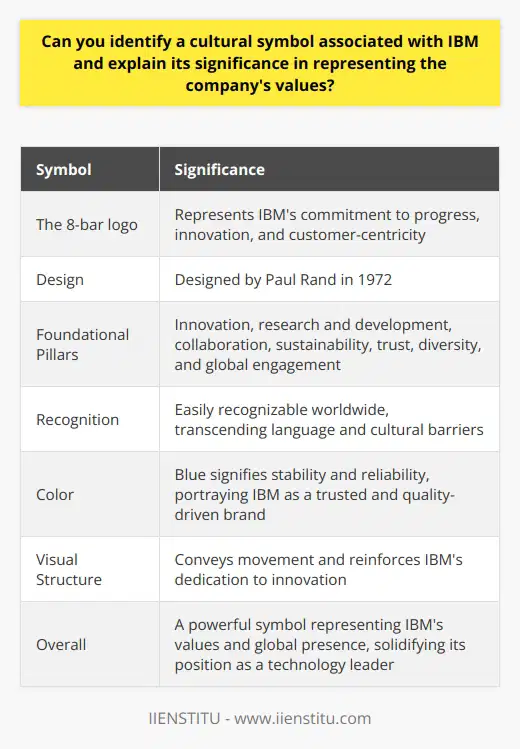
How does IBM's cultural framework drive innovation within the organization?
IBM's Cultural Framework and its Role in Driving Innovation
Organizational Values
IBM's cultural framework fosters innovation through its emphasis on the organization's core values. These values, which include dedication to client success, innovation that matters, and trust and personal responsibility in all relationships, set the foundation for an environment in which creativity and out-of-the-box thinking can flourish. By committing to these principles, IBM employees are encouraged to actively seek opportunities for improvement and come up with innovative solutions that benefit their clients and the organization as a whole.
Collaborative Approach
Collaboration is another key aspect of IBM's culture that drives innovation within the organization. The company promotes an open exchange of ideas and advocates for the inclusion of diverse perspectives. This approach not only encourages teamwork, but also helps in creating a variety of novel ideas and solutions that may not have been developed in a more siloed or individualistic work environment. By harnessing collective intelligence and encouraging cross-functional cooperation, IBM leverages its vast wealth of knowledge and experience to foster an atmosphere that propels ongoing innovation.
Embracing Change
One characteristic that is deeply ingrained in IBM’s culture is its willingness to adapt and embrace change. Recognizing the importance of constant evolution in a rapidly evolving technological landscape, IBM continuously reevaluates its strategies and practices to stay ahead of the curve. This dynamic nature fosters a sense of adaptability among employees and an openness to innovative ideas. As a result, the organization nurtures a mindset of continuous learning and experimentation, enabling employees to adapt and develop their skills to remain relevant and contribute to the company's innovative initiatives.
Building on Employee Expertise
IBM's commitment to employee development plays a crucial role in fostering innovation within the organization. The company invests significantly in learning and development programs aimed at enhancing its workforce's skills and expertise. Employees are thus enabled to extend their capabilities and explore new areas, which in turn can lead to the development of innovative technologies, products, and solutions. By empowering employees with opportunities for growth, IBM cultivates a culture that values continuous development and knowledge expansion, lending itself to a perpetually innovative environment.
In conclusion, IBM's cultural framework drives innovation within the organization by promoting core values, encouraging collaboration, embracing change, and building on employee expertise. The alignment of these factors contributes to an environment that fosters creativity and the development of groundbreaking solutions in the field of technology.
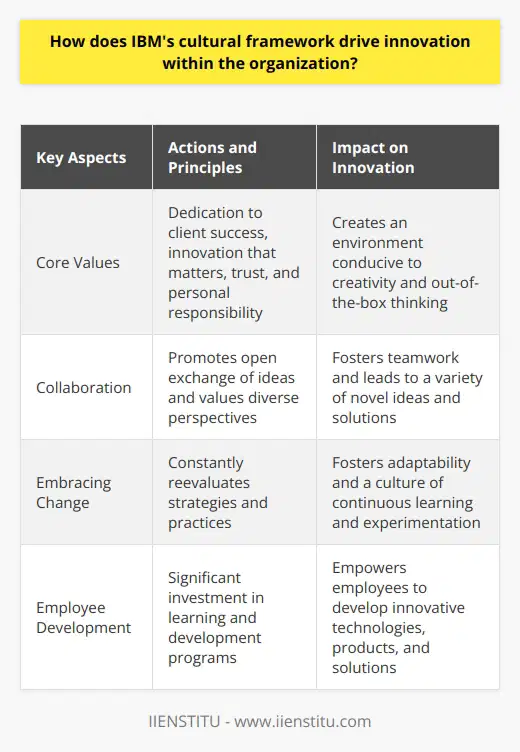
In what ways do IBM's cultural values facilitate collaboration and inclusivity?
Impact of IBM's Cultural Values
IBM's cultural values play a vital role in fostering collaboration and inclusivity within the organization. The company has long advocated for an inclusive work environment, embracing diversity as a core tenet of its corporate culture.
Promotion of Diversity and Inclusion
One way IBM achieves this is by actively promoting diversity and inclusion through various company-wide initiatives and strategies. For instance, the company has established employee resource groups, which serve as platforms for employees from different backgrounds to connect, share experiences, and support each other. Moreover, IBM invests in targeted programs to attract talent from minority groups, ensuring that it maintains a diverse workforce.
Emphasis on Teamwork
IBM also encourages a collaborative work environment, emphasizing teamwork and the sharing of knowledge among employees. This is achieved through a strong emphasis on open communication channels and the implementation of collaborative tools such as Shared Workspaces, Instant Messaging, and Video Conferencing systems. These tools help to break down any perceived barriers among employees, fostering a sense of belonging and teamwork.
Focus on Learning and Development
Additionally, IBM encourages continuous learning and development among its employees, which creates an environment where new ideas and perspectives are welcomed. This approach helps to ensure that employees feel valued and engaged, ultimately driving collaboration and inclusivity. IBM often holds regular learning and development events such as workshops and seminars, providing employees with opportunities to acquire new skills and broaden their horizons professionally.
Employee Empowerment
IBM also empowers its employees by granting them autonomy in their work processes, encouraging them to take responsibility for their actions and decisions. This autonomy allows employees to make more informed decisions, trust their colleagues and take the initiative in driving innovation. Through these measures, IBM creates an environment where employees feel valued and are able to contribute their ideas and expertise, driving progress and collaboration.
Merit-based approach
Finally, IBM's merit-based approach to employee recognition and rewards fosters a culture of inclusivity, as it implies that employees are acknowledged and rewarded based on their performance and contributions, irrespective of their background or status within the organization. This meritocracy creates a level playing field where employees are encouraged to express their ideas, collaborate, and contribute to the growth of the organization.
In conclusion, IBM's cultural values such as promoting diversity and inclusion, emphasizing teamwork, focusing on learning and development, empowering employees and adopting a merit-based approach, actively facilitate collaboration and inclusivity among its employees. This culture of inclusion fosters a creative atmosphere and helps drive innovation and growth at the company.
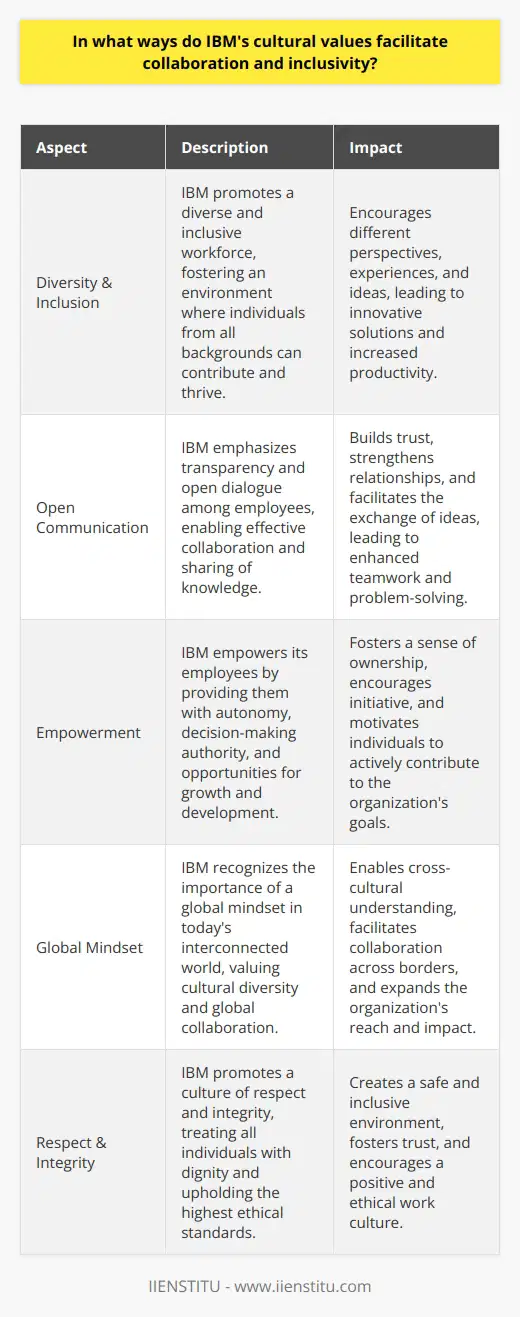
How has IBM's work culture evolved over time to promote continuous adaptation and transformation?
IBM's Historical Evolution
IBM's work culture has evolved significantly throughout its history, fostering continuous adaptation and transformation. Initially, a culture of strict rules and regulations, characterized by a formal dress code and hierarchical structure, marked IBM's work environment. However, by the beginning of the 21st century, significant shifts began to occur in the organization's work culture, promoting flexibility and offering employees a more relaxed and creative work environment.
Flattening Hierarchies and Encouraging Entrepreneurship
One key change in IBM's work culture has been the flattening of organizational hierarchies, enhancing agility and promoting more collaboration between cross-functional teams. This shift has encouraged employees to come up with innovative solutions to solve organizational challenges while also fostering a sense of entrepreneurship within the company. Employees are trusted more than ever to direct and manage their own work, provided they align with IBM's strategic objectives.
Embracing Diversity and Inclusion
IBM's work culture has also evolved to embrace diversity and inclusion as part of its core values. The organization is committed to creating a diverse workforce by attracting, developing, and retaining talent from diverse backgrounds, regardless of age, race, gender, sexual orientation, or disability. This focus on diversity has fostered a more inclusive work environment that enables employees to bring their unique perspectives, experiences, and skills to the table, ultimately contributing to the company's innovation and growth.
Leveraging Technology for Collaboration
The adoption of technology is another critical aspect of IBM's evolving work culture. IBM has deployed various digital tools and platforms to facilitate remote work, virtual collaboration, and the seamless sharing of ideas and resources between teams worldwide. This effort has not only enabled employees to work more efficiently and effectively, but it has also promoted a culture of continuous learning and adaptability, as teams collaborate and adapt to emerging technologies seamlessly.
Fostering a Learning Culture
Lastly, IBM has focused on fostering a learning culture among its employees, investing in skill development and offering various training opportunities to support both personal and professional growth. With the rapid pace of change in the technology landscape, continuous learning has become essential at IBM, as it keeps employees informed about industry trends and empowers them to stay ahead of competitors.
In conclusion, IBM's work culture has evolved remarkably over time, promoting continuous adaptation and transformation among its employees by flattening hierarchies, embracing diversity, leveraging technology for collaboration, and fostering a learning culture. These changes have allowed IBM to maintain a competitive edge and continue to be a leader in the technology industry.
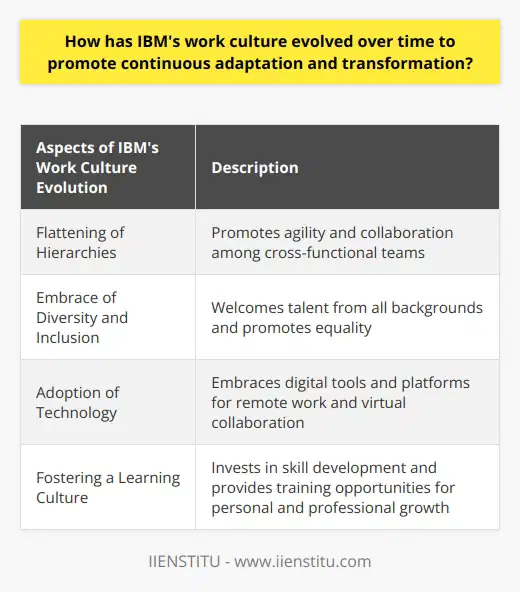
What factors contributed to the development of IBM's unique work culture?
IBM's Work Culture: An Overview
IBM's unique work culture developed due to a myriad of influencing factors. Foremost amongst these was continual investment in their people, their most valuable asset. The company propagated a culture of lifelong learning, encouraging employees to constantly improve their skills and knowledge.
Proactive Collaboration and Innovation
IBM also developed an environment that fostered teamwork and collaboration. Employees pursued shared goals instead of competing against each other. This approach allowed them to leverage diverse perspectives, fostering new ideas and better problem-solving. In addition, IBM’s culture of innovation meant employees would continually push boundaries and question the status quo.
Ethica.l Employment Practices
Moreover, IBM’s ethical employment practices played a crucial role in shaping its work culture. The company was one of the first to implement equal opportunity policies. This resulted in a more diverse and inclusive workforce, contributing to their unique work atmosphere.
Resilience in IBM's DNA
Lastly, a culture of resilience at IBM made a significant contribution. As a tech giant continually evolving in a competitive industry, IBM encountered several challenges. However, the resilient culture empowered employees to overcome these obstacles, fostering growth and development.
In conclusion, IBM's unique work culture emerged due to several key factors, including investment in employee growth, a collaborative environment, ethical employment practices, and resilience in the face of challenge. These factors produced a distinct workplace environment that continues to stand out in the corporate world.
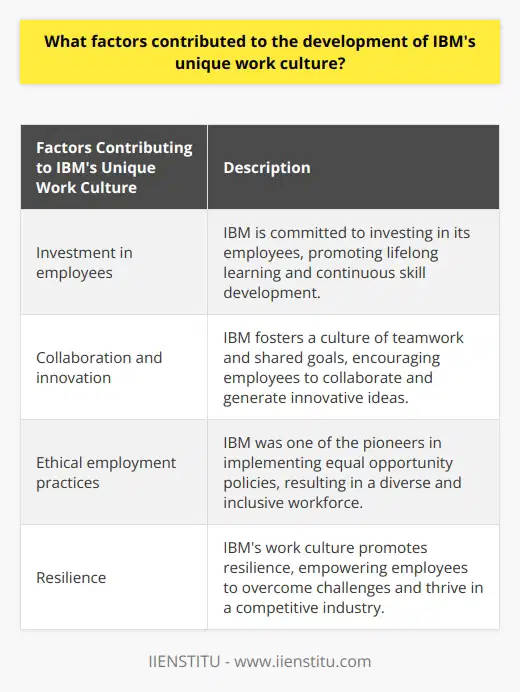
How does the alignment between IBM's corporate culture and its business strategy enhance the company's overall performance?
Alignment of Corporate Culture and Business Strategy
The harmony between IBM's corporate culture and its business strategy significantly improves the firm's overall performance.
Enhanced Employee Engagement
Firstly, the alignment fosters employee engagement. IBM’s corporate culture nurtures a sense of belonging and ownership among employees. Coupled with a clear business strategy, the employees better understand their roles. This clarity motivates them to execute their functions more effectively and efficiently.
Stimulating Innovation
Secondly, this alignment stimulates innovation. IBM’s culture of promoting creative thinking dovetails with its strategy of leading in the technology field. Together, they encourage employees to generate fresh ideas. Innovation-driven strategies have helped maintain IBM's market position as a technology leader.
Improved Decision Making
Also, aligned corporate culture and business strategy streamline decision making. The corporate culture focuses on transparency and collective decision-making. That, along with a well-defined strategy, enables employees to make faster and better decisions.
Greater Customer Satisfaction
Furthermore, this congruity enhances customer satisfaction. IBM’s culture of prioritizing customer needs aligns with its client-oriented business strategy. They work together to deliver superior value to customers, thereby enhancing their satisfaction and loyalty.
Better Problem-solving Capability
Lastly, this alignment improves problem-solving abilities. IBM's problem-solving culture pairs well with its strategy of constantly improving operations. It aids in identifying business challenges swiftly and finding effective solutions.
In conclusion, the symbiosis between IBM's corporate culture and business strategy amplifies the company's overall performance. It boosts employee engagement, invigorates innovation, streamlines decision making, increases customer satisfaction, and enhances problem-solving capabilities, which together drive the company to greater heights.
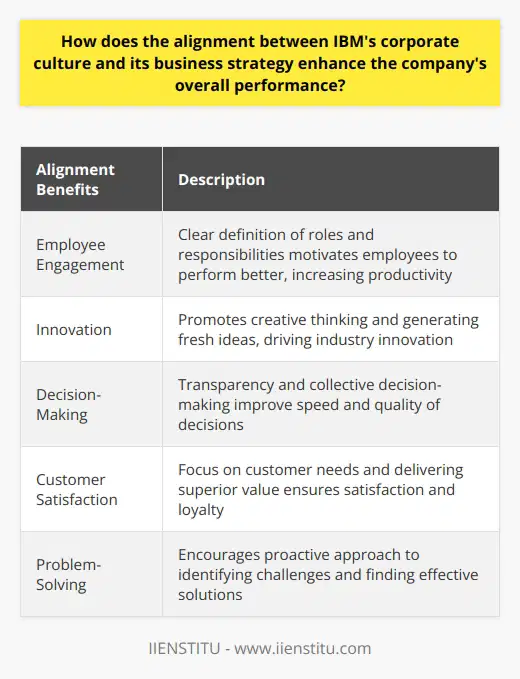
In what ways does IBM's cultural emphasis on continuous learning and improvement support the professional growth of its employees?
Enhancing Skillsets through Continuous Learning
IBM's cultural emphasis on continuous learning significantly contributes to its employees' professional growth. The practice encourages employees to acquire new skills continuously, which increases their competence. This proficiency aids employees in their career development and progression.
Employee Engagement and Motivation
Moreover, the culture of learning keeps employees engaged and motivated. Regular training sessions, workshops, and seminars provide them with fresh insights and perspectives. It makes the workplace stimulating and challenging, driving employees to perform better.
Innovation and Improvement
Encouraging continuous learning also sparks innovation. As employees widen their knowledge repository, they become more capable of generating novel ideas. Thus, this learning culture creates a conducive environment for innovation and improvement.
Adaptability to Change
IBM’s learning culture also equips employees to swiftly adapt to industrial changes. As the technology sector is notoriously fast-paced, acquiring the ability to quickly learn and implement new techniques or processes is crucial. Therefore, continuous learning helps maintain employee relevance in the ever-evolving tech sector.
Teamwork and Collaboration
The learning culture facilitates teamwork and collaboration. While pursuing common learning goals, the employees collaboratively find solutions and learn from each other. Consequently, this improves communication, fosters better relationships among colleagues, and enhances overall team productivity.
Therefore, IBM's focus on continuous learning offers holistic professional growth. The resulting increase in skills, adaptability, and innovation not only benefits the individual employee but also enhances IBM's overall productivity and success.
